

End Your Sleep Deprivation - Empower Yourself With Sleep and Dreams Knowledge. Home. Clinical Implications of the Melatonin Phase Response Curve. 301108.pdf. American Academy of Sleep Medicine – Association for Sleep Clinicians and Researchers. Vitamin B12 - Circadian Sleep Disorders Network. For links to content on this page, click anywhere on the text below.
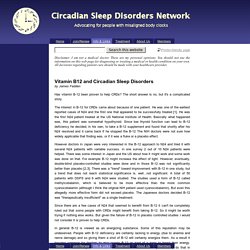
Click again to remove. Disclaimer: I am not a medical doctor. These are my personal opinions. You should not use the information on this web page for diagnosing or treating a medical or health condition on your own. All decisions regarding patient care should be made with your healthcare provider. by James Fadden Has vitamin B-12 been proven to help CRDs? The interest in B-12 for CRDs came about because of one patient. However doctors in Japan were very interested in the B-12 approach to N24 and tried it with several N24 patients with variable success.
Since there are a few cases of N24 that seemed to benefit from B-12 it can't be completely ruled out that some people with CRDs might benefit from taking B-12. In general B-12 is viewed as an energizing substance. JetLagged for Life. Please – take time to read the comments.

We are NOT alone! (c) Madelyn Griffith-Haynie, CTP, CMC, ACT, MCC, SCACPart 1 of the Sleep Struggles Series – all rights reservedLiving with Jet LagA first person account of an ADDer with an atypical sleep disorder — me. Sleephealthjournal. New Healthy Energy. New Health Concerns. Psychosomatica. Ἰδιοσυγκρασία. Human Self. Circadian Sleep Disorders Network.
Thalamic deactivation at sleep onset precedes that of the cerebral cortex in humans. Hypnagogia and Hypnopompia. Hypnagogia is the imagery, sounds and strange bodily feelings that are felt at “sleep onset.”

This is a simplification though, as researchers have noted hypnagogic imagery in the lab at periods of quiet wakefulness as well as stage 1 sleep. Others have correlated hypnagogia with pre-sleep alpha waves and also REM intrusion into sleep onset. The truth is that the wake-sleep transition is still not understood. And neither are its trippy visuals. whispy lights, multi-dimentional geometric objects, or a sudden image like a stranger’s face Few people remember hypnagogic imagery. Strange noises, voices and rushing sounds are typical, as well as weird mechanistic sounds like beeps and boops. Some hear music — I personally have had lucid hypnagogic orchestras from time to time, with the ability to listen passively or focus on a particular instrument to induce a solo.
Psychophysiology of Lucid Dreaming. By Stephen LaBerge, Ph.D.

Lucid Dreaming Physiologically Verified Although we are not usually explicitly aware of the fact that we are dreaming while we are dreaming, at times a remarkable exception occurs, and we become conscious enough to realize that we are dreaming. "Lucid" dreamers (the term derives from van Eeden, 1913) report being able to freely remember the circumstances of waking life, to think clearly, and to act deliberately upon reflection, all while experiencing a dream world that seems vividly real (Green, 1968; LaBerge, 1985; Gackenbach & LaBerge, 1988). This is all in contrast to the usual past characterization of dreams as typically lacking any reflective awareness or true volition (Rechtschaffen, 1978). Lucid dreaming is normally a rare experience. Though most people report having had a lucid dream at least once in their lives, only about 20% of the population reports having lucid dreams once a month or more (Snyder & Gackenbach, 1988).
Figure 1. Figure 2. A Good Night's Sleep. Ever since he retired, Edward dreads going to bed at night.
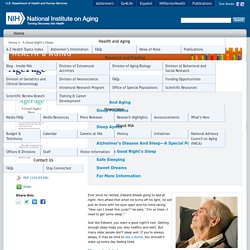
He’s afraid that when he turns off his light, he will just lie there with his eyes open and his mind racing. “How can I break this cycle?” He asks. “I’m so tired—I need to get some sleep.” Just like Edward, you want a good night’s rest. Handout_sleep.pdf. Sleep and Neuroimaging Laboratory - Matthew Walker.
Untitled. Melatonin for Treatment of Sleep Disorders: Summary of Evidence Report/Technology Assessment, No. 108. Summary Evidence Report/Technology Assessment: Number 108 This information is for reference purposes only.

It was current when produced and may now be outdated. Archive material is no longer maintained, and some links may not work. Persons with disabilities having difficulty accessing this information should contact us at: Let us know the nature of the problem, the Web address of what you want, and your contact information. Please go to www.ahrq.gov for current information. Under its Evidence-based Practice Program, the Agency for Healthcare Research and Quality (AHRQ) is developing scientific information for other agencies and organizations on which to base clinical guidelines, performance measures, and other quality improvement tools.
Select to download the print version (PDF File, 109 KB). Introduction / Methods / Data Analysis / Results / Discussion / Safety of Melatonin / Future Research / Limitations of the Review / Conclusions / Availability of Full Report / References Introduction. PhysioNet. Sleep Data - National Sleep Research Resource - NSRR. Narcolepsy. Healthysleep.med.harvard. Psycho.aisthetikos. Altered States. Visual impairment and circadiam rhythm disorders. Sleep Encyclopedia A-Z - American Sleep Association. Parasomnias - American Sleep Association. American Academy of Sleep Medicine – Association for Sleep Clinicians and Researchers. IPSA > Home. WASM. Sleep Medicine. Serum Nutritional Biomarkers and Their Associations with Sleep among US Adults in Recent National Surveys. Neuroförbundet. Search for expert centres. Je-dors-trop.fr - Maladie et troubles du sommeil, narcolepsie.
Mystic Crystal Revelation. On the Pharm. Ecstatic auras, Temporal Lobe Epilepsy, 'Depression' I am desperate to find some feedback from the community about the specific sensations I experience with my temporal lobe epilepsy.
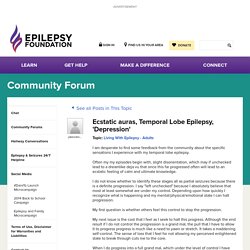
Often my my episodes begin with, slight disorientation, which may if unchecked lead to a dreamlike deja vu that once this far progressed often will lead to an ecstatic feeling of calm and ultimate knowledge. I do not know whether to identify these stages all as partial seizures because there is a definite progression. I say "left unchecked" because I absolutely believe that most at least somewhat are under my control.
Depending upon how quickly I recognize what is happening and my mental/physical/emotional state I can halt progression. My first question is whether others feel this control to stop the progression. My next issue is the cost that I feel as I seek to halt this progress. The closest writings I have found which relate to my condition come Again, my questions are: Does anyone else feel this direct control over the progression of their episodes? Reticular activating system. History and Etymology[edit] Moruzzi and Magoun first investigated the neural components regulating the brain’s sleep-wake mechanisms in 1949.
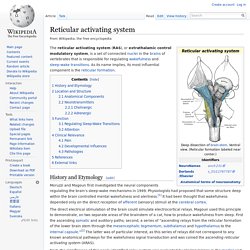
Physiologists had proposed that some structure deep within the brain controlled mental wakefulness and alertness.[1] It had been thought that wakefulness depended only on the direct reception of afferent (sensory) stimuli at the cerebral cortex. The direct electrical stimulation of the brain could simulate electrocortical relays. Magoun used this principle to demonstrate, on two separate areas of the brainstem of a cat, how to produce wakefulness from sleep. Next, the significance of this newly identified relay system was evaluated by placing lesions in the medial and lateral portions of the front of the midbrain. Finally, Magoun recorded potentials within the medial portion of the brain stem and discovered that auditory stimuli directly fired portions of the reticular activating system. Location and Structure[edit] Modafinil. Modafinil is a wakefulness-promoting agent[3] (or eugeroic) that is approved by the United States' Food and Drug Administration (FDA) for treatment of wakefulness disorders such as narcolepsy, shift work sleep disorder,[4][5] and excessive daytime sleepiness associated with obstructive sleep apnea.[6] In English-speaking countries it is sold under the brand names: Alertec (CA), Modavigil (AU, NZ), and Provigil (IE, ZA, UK, US).
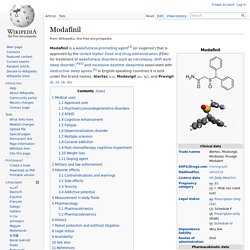
Medical uses[edit] Approved uses[edit] In 1998, modafinil was approved by the U.S. The Paradox of Sleep translation Anglais. J.1365-2869.1999.00128.x. Dtic. Lucid Dreaming and Consciousness Research. International Association for the Study of Dreams. International Association for the Sudy of Dreams. IASD encourages its members to host regional meetings and co-sponsored events, and IASD will provide logistical and financial support to promote such events.

The benefits of regional meetings and co-sponsored events are twofold. First, they help IASD members in a particular geographical region to meet each other, socialize, network, and share their different approaches to dreams. Second, they help to advance the basic mission of IASD, which is to broaden public awareness and appreciation of dreams. Although these are the primary goals, another aim is to generate new funds for IASD’s educational and outreach programs. Dreams, Shamanism, & Mythology.
Well Health. Human Condition. Being Human. Integrative Medicine. Complementary Medicine. Shaman Guides. Ἰδιοσυγκρασία. Μετάνοια. Food Water Exercise. New Brain Health. Mind Altering Neurology. Magical Thinking.